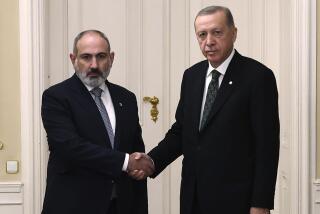A Land Divided: The Armenia/Azerbaijan Crisis : POINTS OF REBELLION : The Issues
- Share via
Religious bigotry and ethnic hatred are at the top of the list of issues separating the two peoples. The Armenians--mainly Christian for centuries--see the Turkic-speaking Muslim Azerbaijanis as relatives of the Turks they hold responsible for a series of Armenian massacres, including the 1915 genocide in which more than 1 million Armenians were killed. For the Azerbaijanis, Islam is a central part of their national identity, and they regard the Armenians profession of Christianity as an assertion of unwarranted superiority.
* Much of the conflict has also centered on the future of the Armenian enclave of Nagorno-Karabakh, inside the Soviet Socialist Republic of Azerbaijan, which wants to be part of the Soviet Socialist Republic of Armenia. Although Nagorno-Karabakh does not border on Armenia, Armenians contend that this should not be an obstacle to the enclave’s territorial transfer, noting that the Azerbaijani region of Nakhichevan--sandwiched between Armenia and Iran--lies more than 18 miles from the nearest Azerbaijani border. However, since the current strife erupted in February, 1988, the Kremlin has ruled out any redrawing of borders on the grounds that breaking the links forged between the rest of Nagorno-Karabakh and the rest of Azerbaijan would cause grave economic damage. Other factors, among them nationalism, contribute to the unrest.
The Spark
* A rally in the Azerbaijani capital of Baku by tens of thousands of people demanding independence from the Soviet Union, gave way to anti-Armenian rioting. Armenians in the city were dragged from their homes, beaten and sometimes killed by roving gangs of Azerbaijanis. Thousands of Armenians in fear for their lives, fled to Armenia and Moscow. Rival militias made up of Armenians and Azerbaijanis took to the streets after capturing arms from Soviet military posts. Scores of people were killed in the first few days of fighting. The Soviet national government imposed a state of emergency in parts of Azerbaijan and dispatched about 10,000 peacekeeping troops from various branches of the military, the Interior Ministry and the KGB or secret police.
More to Read
Sign up for Essential California
The most important California stories and recommendations in your inbox every morning.
You may occasionally receive promotional content from the Los Angeles Times.










